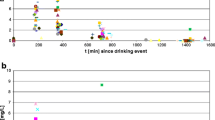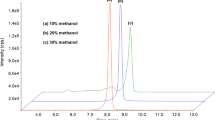Abstract
The forensic utility of N-acetyltaurine (NAcT) in urine as a marker for ethanol intake was examined. A HILIC-based liquid chromatography method for the mass spectrometric determination of NAcT, taurine, and creatinine in urine was developed and validated to investigate NAcT formation and elimination in a drinking study. Thereby, eight subjects ingested 0.66 to 0.84 g/kg alcohol to reach a blood alcohol concentration (BAC) of 0.8 g/kg. Blood and urine were taken every 1.5–2 h, during the first 8 h. NAcT and taurine levels were measured and corrected for the urine’s dilution by normalization to a creatinine concentration of 1 mg/mL. For the determination of NAcT and taurine, uncorrected lower limits of quantitation (LLOQs) were at 0.05 μg/mL of urine. In the drinking study, NAcT proved to be an endogenous compound, which is present at a range of 1.0 to 2.3 μg/mL in urine of alcohol-abstinent subjects. Maximum NAcT concentrations were reached in samples taken 3 to 6 h after the start of drinking, whereby an upregulation in N-acetyltaurine could be found for all the subjects. The mean peak concentrations (c̅ max) of 14 ± 2.6 μg/mL (range 9–17.5 μg/mL) were reached. Within 24 h, the NAcT levels declined to endogenous concentrations. The detectability of NAcT was found to be slightly shifted compared to BAC: When BAC was not detectable anymore, NAcT levels were still elevated. After 24 h, when ethyl glucuronide (EtG) and ethyl sulfate (EtS) were still detectable, NAcT concentrations showed endogenous levels again. Positive NAcT results can be used as an indicator for recent alcohol consumption. A direct relationship between NAcT and taurine concentrations could not be found.

N-acetyltaurine concentrations for eight subjects during the first 24 h after an alcohol consumption of 0.8 g/kg





Similar content being viewed by others
References
WHO. Alcohol: global status report on alcohol and health. World Health Organization. 2014.
Schroeck A, Thierauf A, Wurst FM, Thon N, Weinmann W. Progress in monitoring alcohol consumption and alcohol abuse by phosphatidylethanol. Bioanalysis. 2014;6(17):2285–94.
Shi X, Yao D, Chen C. Identification of N-acetyltaurine as a novel metabolite of ethanol through metabolomics-guided biochemical analysis. J Biol Chem. 2012;287(9):6336–49.
Jokiel M, Skopp G. N-Acetyltaurine—preliminary work to prove its potential as a marker of alcohol consumption. Toxichem Krimtech 2015. 2015 03.05.2016;82((Special Issue):202):5.
Cederbaum AI. Alcohol metabolism. Clin Liver Dis. 2012;16(4):667–85.
Miyazaki T, Ishikura K, Honda A, Ra SG, Komine S, Miyamoto Y, et al. Increased N-acetyltaurine in serum and urine after endurance exercise in human. Adv Exp Med Biol. 2015;803:53–62.
Redondo AH, Korber C, Konig S, Langin A, Al-Ahmad A, Weinmann W. Inhibition of bacterial degradation of EtG by collection as dried urine spots (DUS). Anal Bioanal Chem. 2012;402(7):2417–24.
Luginbuhl M, Schrock A, Konig S, Schurch S, Weinmann W. Determination of fatty acid ethyl esters in dried blood spots by LC-MS/MS as markers for ethanol intake: application in a drinking study. Anal Bioanal Chem. 2016;408(13):3503–9.
Hernández Redondo A, Schroeck A, Kneubuehl B, Weinmann W. Determination of ethyl glucuronide and ethyl sulfate from dried blood spots. Int J Legal Med. 2013;127(4):769–75.
Luginbühl M, König S, Schürch S, Weinmann W. N-Acetyltaurine and EtG in blood as ethanol marker in a drinking study. Submitted to ABC in July.
Matuszewski BK, Constanzer ML, Chavez-Eng CM. Strategies for the assessment of matrix effect in quantitative bioanalytical methods based on HPLC-MS/MS. Anal Chem. 2003;75(13):3019–30.
Acknowledgments
We would like to thank Sidonia Guggisberg, Anita Iannone, Anja Kaiser, Severine Krönert, Nadja Utiger, and Thomas Wüthrich of the Forensic Toxicology and Chemistry Laboratory of the Institute of Forensic Medicine Bern for the determination of blood alcohol concentrations.
Author information
Authors and Affiliations
Corresponding author
Ethics declarations
The drinking study has been approved by the Cantonal Ethics Commission Bern (064/13) on March 3, 2014. The participants of the drinking study gave informed consent for the analysis of direct alcohol marker in the collected samples.
Conflict of interest
The authors declare that they have no conflict of interest.
Electronic supplementary material
Below is the link to the electronic supplementary material.
ESM 1
(PDF 571 kb)
Rights and permissions
About this article
Cite this article
Luginbühl, M., Rutjens, S., König, S. et al. N-Acetyltaurine as a novel urinary ethanol marker in a drinking study. Anal Bioanal Chem 408, 7529–7536 (2016). https://doi.org/10.1007/s00216-016-9855-7
Received:
Revised:
Accepted:
Published:
Issue Date:
DOI: https://doi.org/10.1007/s00216-016-9855-7




